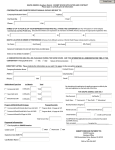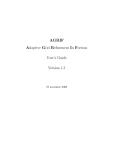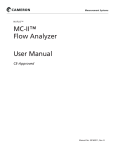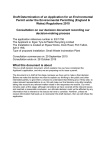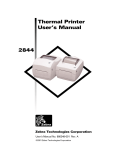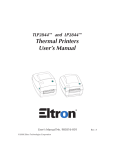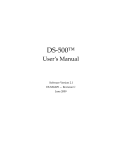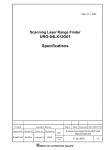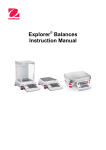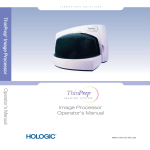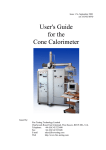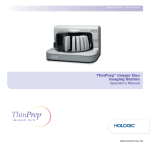Download MFI 9 Melt Flow Indexer User Manual
Transcript
Part No. 01/2810 July 2013 MFI 9 Melt Flow Indexer User Manual MFI 9 User Manual 1 WARRANTY This instrument is warranted against defects in workmanship, material and design for one (1) year from date of delivery to the extent that AMETEK will, at its sole option, repair or replace the instrument or any part thereof which is defective, provided, however, that this warranty shall not apply to instruments subjected to tampering or, abuse, or exposed to highly corrosive conditions. THIS WARRANTY IS IN LIEU OF ALL OTHER WARRANTIES WHETHER EXPRESS OR IMPLIED AND AMETEK HEREBY DISCLAIMS ALL OTHER WARRANTIES, INCLUDING, WITHOUT LIMITATION, ANY WARRANTY OF FITNESS FOR A PARTICULAR PURPOSE OR MERCHANTABILITY. AMETEK SHALL NOT BE LIABLE FOR ANY INCIDENTAL OR CONSEQUENTIAL DAMAGES, INCLUDING, BUT NOT LIMITED TO, ANY ANTICIPATED OR LOST PROFITS. This warranty is voidable if the purchaser fails to follow any and all instructions, warnings or cautions in the instrument’s Instruction Manual. If a manufacturing defect is found, AMETEK will replace or repair the instrument or replace any defective part thereof without charge; however, AMETEK’s obligation hereunder does not include the cost of transportation, which must be borne by the customer. AMETEK assumes no responsibility for damage in transit, and any claims for such damage should be presented to the carrier by the purchaser. TRADEMARKS AMETEK is a registered trademarks of AMETEK, Inc. LLOYD INSTRUMENTS is a trademark of AMETEK, Inc. DAVENPORT is a trademark of AMETEK, Inc. Other trademarks are the property of their respective owners. SUPPORT AMETEK Lloyd Instruments Ltd Steyning Way Bognor Regis West Sussex UK PO22 9ST Tel: +44 (0) 1243 833 370 Fax: +44 (0) 1243 833 401 Email:[email protected] Internet:www.lloyd-instruments.co.uk AMETEK Measurement and Calibration Technologies 8600 Somerset Drive Largo, FL 33773 USA Tel:+1-727-536-7831 Tel: +1-800-527-9999 (within USA only) Email: [email protected] 2 MFI 9 User Manual Icons WARNING The raised hand icon warns of a situation or condition that may lead to personal injury or death. Do not proceed until the warning is read and thoroughly understood. Warning messages are shown in bold type. DANGEROUS VOLTAGE The lightning icon warns of the presence of an uninsulated dangerous voltage within the product enclosure that might be of sufficient magnitude to cause serious shocks or death. Never open the enclosures unless you are an authorized and qualified LLOYD INSTRUMENTS’ service personnel. Never open any enclosure when power is connected to the system or its components. CAUTION The exclamation point icon indicates a situation or condition that may lead to equipment malfunction or damage. Do not proceed until the caution message is read and thoroughly understood. Caution messages are shown in bold type. NOTE The note icon indicates additional or supplementary information about the action, activity or concept. Notes are shown in bold type. CAUTION HIGH TEMPERATURES AND MOLTEN PLASTIC ARE INVOLVED IN THE MFI PROCESSES. ALL SPECIFIED SAFETY PROCEDURES SHOULD BE STRICTLY ADHERED TO. READ THIS MANUAL BEFORE USING THE MFI MODEL 10. THE THERMOMETER(S) SUPPLIED ARE GLASS AND CONTAIN MERCURY, PLEASE STUDY SECTION 8 OF THIS MANUAL. BEFORE USING THE MATERIALS TESTING MACHINE. General Safety General safety precautions must be followed when using this LLOYD INSTRUMENTS product. Failure to observe precautions and warnings may result in damage to the equipment, or injury to personnel. It is understood that safety rules within companies vary. If a conflict exists between the material contained in all LLOYD INSTRUMENTS’ User’s Guides and the rules of a company using a DAVENPORT product, the more stringent rules should take precedence. Safety Considerations The MFI 9 is completely enclosed and provides no potentially hazardous outputs. Safety considerations are related to the power connections and physical mountings. Electronic and mechanical components housed within the MFI 9 covers are to be serviced by authorized DAVENPORT representatives only. MFI 9 User Manual 3 TABLE OF CONTENTS Page 1.0 1.1 1.2 1.3 1.4 INTRODUCTION................................ Melt Flow Rate.................................... Other Applications of the Apparatus.... Die Swell............................................. Draw Down......................................... 2.0 factorS effecting measurement. 6 3.0 3.1 3.2 3.3 3.4 3.5 3.6 3.7 3.8 3.9 3.10 3.11 3.12 3.13 3.14 3.15 3.16 3.17 3.18 the apparatus............................... 8 The Barrel (or Cylinder)...................... 8 The Heater.......................................... 8 Temperature Controller....................... 9 The Dies.............................................. 9 The Die Plate...................................... 9 The Piston.......................................... 10 Control Panel..................................... 11 Using the Control Panel..................... 11 Test Procedure................................... 12 Selecting the Test Setups.................. 16 Test Setup Mode................................ 17 Calibration Mode................................ 19 Entering Passwords........................... 21 Commission Mode............................. 21 Self Test Mode................................... 23 Clear Internal Memory....................... 23 Additional Features............................ 24 Additional Requirements.................... 24 4 MFI 9 User Manual 5 5 5 6 6 Page 4.0 4.1 4.2 4.3 4.4 4.5 4.6 4.7 installation.................................. Unpacking List................................... Siting Your Machine........................... On-Off Switch..................................... Electrical Safety................................. Preparation of Apparatus................... Temperature Control.......................... Cut-Off Tmer Operation..................... 25 25 25 25 26 26 27 28 5.0 calculation and presentation of results............................................ 29 6.0 operating technique................ 6.1 Cutting Off the Extrudate................... 6.2 The Importance of Piston Grooves.... 6.3 Form of Test Sample.......................... 6.4Cleaning............................................. 6.5 Differences in Test Conditions............ 30 30 30 30 31 32 7.0 general maintenance............... 32 8.0 spare items for MFI 9................ 33 9.0 test conditions.......................... 36 10.0 specifications............................. 37 1.0 INTRODUCTION TO MELT FLOW INDEXING 1.1 MELT FLOW RATE The melt flow rate (MFR) of a thermoplastic material is the measured gravimetric flow of the sample extruded through a die following specified conditions of die length, diameter, temperature and pressure. Different standardised conditions of extrusion temperatures and pressures are used for different types of polymer but, for the purpose of comparison, samples of the same type of polymer should be tested under identical conditions. The MFI Apparatus may be regarded as a rheometer operating at conditions of low shear. Although the shear stresses applied and the resultant shear rates are much lower than those used in the processes, the results obtained do provide a useful indication as to the relative ease with which different materials will flow when processed. Since higher MFR values indicate easier melt flow, a grade of polymer with a high MFR is generally chosen when the process envisaged involves relatively high rates of shear, i.e. injection moulding. MFR is also a measure of the molecular weight of a sample and is indicative of the mechanical strength of a material. Average molecular weight and MFR are indirectly proportional, so that, although a sample of high MFR will process more readily, its melt strength is likely to be low. 1.2 OTHER APPLICATIONS OF THE APPARATUS In addition to determining the MFR, the apparatus can be used to measure other properties of the polymer providing useful knowledge of its behaviour. By performing the MFR test under two or more different loads, useful information about the rheological properties of the material can be found. It could be wrongly assumed that two polymer samples with the same MFR will behave in the same way with respect to output (shear rate) when tested under the same conditions. When subjected to the higher pressures (shear stress) required for a moulding or extrusion process, they could perform quite differently. If the samples have different Molecular Weight Distributions (MWD) the increase in the shear rate resulting from an identical increase in shear stress will be different as well. In general, a large MFI 9 Melt Flow Indexing Machine MWD corresponds with a greater shear sensitivity, i.e. a higher rate of change in shear rate per unit increase in shear stress. A useful measure of the shear stress/shear rate relationship (flow parameter) can be made by measuring the MFR at standard load and at a higher load. Increasing the test load (for polyethylenes) from the standard 2.16Kg to 21.6Kg loads, increases the level of shear rate by factor between 50 and 100:1, depending on the MWD of the sample and the simple arithmetic ratio. MFR 21.6Kg/MFR 2.16Kg gives a measure of the flow parameters. Depending on the MFRs at 2.16Kg load, the value at 21.6Kg can be equivalent to shear rates more than 100 secs-1 coming, possibly, into the range of extrusion processes. The facility also exists to measure flow parameters at different temperatures giving an insight as to the temperature sensitivity of the sample. The extrudate generated during the test can also be used to determine other useful parameters of the sample. The emerging sample temperature and the die diameter are known and its rate of cooling and ambient temperature gives “controlled” conditions and is therefore repeatable. Two important properties can be measured more conveniently and with greater precision from the Melt Flow Indexer than from commercial processing equipment. These are Die Swell and Draw Down. MFI 9 User Manual 5 1.3 DIE SWELL Die Swell or swelling ratio, is an arithmetic ratio between the diameter of the cooled extrudate at ambient temperature and the diameter of the die. This is an important factor for processes such as pipe extrusion and blow moulding. 1.4 DRAW DOWN Draw Down is the extending of the polymer extrudate by its own weight as the extrudate lengthens. It is, for example, a requirement of a polymer to have good draw characteristics in the blown moulding process so that a good parison is produced. Because the Die Swell and Draw Down depend on an accurate measurement of the extrudate, it is important that the cross section should be as circular as possible. The most common cause of irregular cross section circularity is draught, causing asymmetric cooling, the equipment should be placed as far away as possible from any draught source. DesiredMolecular ProcessCharacteristic Design Blow Moulding High Melt Strength Low MFR Film Blowing Broad molecular weight distribution Thermoforming Extrusion Low Die Swell Narrow molecular weight distribution Injection Moulding Easy Flow Medium to High MFR Moderate Temperatures Narrow molecular weight distribution Rapid Cycles Figure 1 2.0 factors effecting measurement It is vital that both the equipment and the operator’s technique be in conformance with the published standards. According to the ASTM D 1238, the accuracy of the MFI value obtained for a single measurement between operators and sites, ranges from ±9% to ±15%, the faster flowing polymers giving the most variable results. Tests on the DAVENPORT Lloyd equipment, using three standard polymers of MFI 0.2, 2.0 and 20 on different Davenport models at different sites with the same (independent) operators, gave results with a 1% variance. The standards all allow a machine variance of up to ±10%. Polymers are non-Newtonian: the MFI measured under one set of conditions cannot be extrapolated to apply to any other set of conditions where melt temperature, die dimensions or melt pressure have been altered. Polymers can have similar viscosity in the region of the low shear rates used in MFI test, but very different viscosity at higher shear rates. The MFI test could report two materials as being the same, when under process conditions they might behave very differently. MFI is therefore a simple, one point comparative check used by all processors to check that they have been sent what they ordered, or that they have the correct blend for the job. There are ten factors which can influence MFI measurements adversely and are listed, with their maximum likely error, in the following table. 6 MFI 9 User Manual Maximum Item Factor Likely Error 1 Poor Packaging during Charging +150% (resulting in oxidation and bubbles - piston drops unevenly) 2 Dirty Barrel +100% (contamination with oxidised or different polymer, and piston may stick) 3 Partially Blocked Die -100% 4 Piston Height In Excess of Standard 50mm -50% Within Standard 50mm -15% 5 Delays between Charging & Packing (oxidation) +10% 6 Extended Test Time +5% 7 Worn Die +10% for 0.05mm wear in diameter 8 Worn Piston +10% (automatic recording of piston speed) for 0.013mm wear 9 Test Temperature +1% for 1 °C 10 Variations in Load pro rata Source: ICI data sheet P3/1 Figure 2 Variability arises from three main sources: • • • oxidation degradation. non-Newtonian melt flow behaviour. deviations from set test procedures. It is for these reasons that AMETEK imposes stringent technical specifications on each and every part to ensure all tolerances greatly exceed the published standards. Standard polymers are tested on every machine, and records kept, to ensure system compliance before leaving the factory. Only top quality spares are supplied and customers are urged not to be tempted into short term gain by acquiring cheaper spares elsewhere. Dies are a case in point. Davenport dies are made from top quality tungsten carbide. Other dies have caused disappointment by wearing in a matter of weeks, working out far more expensive in the long run. Barrels can also cause problems if not perfectly spherical. An ovate barrel will not have an even clearance between piston and barrel around the entire circumference. The piston may therefore be slowed, fractionally, giving lower MFI values. To avoid such occurrences, or to check a system which is giving variable results, we strongly recommend an annual service and calibration contract. MFI 9 User Manual 7 3.0the apparatus Long Tools Barrel Column Control Console Figure 3 The Melt Flow Rate apparatus has been designed in accordance with ISO 1133 & ASTM D1238(Method A). A balance, accurate to ±0.5 mg., will be required. ISO 1133 now supersedes all European Standards such as DIN 53735 (Germany), NF: 51-106 (France), UNI 5640-74 (Italy) UNE 53098 (Spain). The apparatus is a dead weight extrusion plastometer with a microprocessor controlled melt chamber (the barrel) in which, under standard set conditions, the test sample of polymer is heated and extruded through a standard die orifice by a known load. All component parts to perform the tests are calibrated within stringent limits required by the above standards. The manual cut-off test (Procedure A) is suitable for materials with an MFR between 0.1 and 250g/10mins or for comparison of filled and unfilled polymers. 3.1 THE BARREL (OR CYLINDER) The barrel is a steel cylinder, 50.8mm diameter and 162mm long, through which a smooth, straight hole 9.55mm diameter has been bored and honed. The barrel has been nitrided to improve surface hardness and reduce wear. A corrosion resistant version is also available, lined with tungsten carbide, to prevent excessive wear by glass fillers and /or corrosive polymers such as PVC. PVC gives off chlorine gas which combines with hydrogen in the air to make HCl, a strong acid. A tungsten carbide coated piston is supplied as standard with the corrosion resistant barrel. The barrel is encased in a double layer of insulating material and the assembly is housed in a sheet metal case. 3.2 THE HEATER The barrel is heated by three cartridge heaters equally spaced around the central bore. Great care is taken to ensure that all our barrel assemblies are produced to close tolerances to give the best heat distribution and temperature stability. 8 MFI 9 User Manual 3.3 TEMPERATURE CONTROLLER The temperature of the barrel is controlled by means of a platinum resistance thermometer (PT100) in conjunction with a micro processor based, three term temperature controller. This enables the operator to select temperature within a standard range of 40 - 400°C which will be accurately held to ±0.1°C. The selection and adjustment of the barrel temperature forms part of the test set-up which is entered from the console and saved when the machine is switched off. 3.4 THE DIES Made of tungsten carbide, these conform precisely to standard dimensions; 8mm long, 9.47mm overall diameter, bore diameter 2.095mm. The bore is very highly finished and is tested to tolerances well inside the closest called for in any published standard, particularly with regard to bell-mouthing. The alternative die called for in BS 2782 method 105C (as jet B) with a bore diameter of 1.181mm, is also available on request as an extra (Die Small). Please note that this is no longer called for in the Method 720A which replaces 105C, or in ISO 1133 which replaces the BS Standard, or the ASTM Standard. However it is still in use for polymers with exceptionally high flow rates. Part No. Description 338/10 Die Standard 2.095mm 338/11 Die Small 1.181mm 3.5 THE DIE PLATE The die plate supports the die and is held in place underneath the barrel by three socket head screws. The die plate is a piece of circular steel with three keyhole slots and a larger round hole in the middle into which the ceramic insert is placed. The non-stick PTFE coating assists with cleaning, and a ceramic insert withstands high temperatures and provides a rigid flat surface for the die to sit on. The ceramic insert sits slightly proud of the die plate in contact with the die and bottom of the barrel. The concave underside enables the cut-off knife to cut the extrudate right up to the base of the die. Insert screws to about half their length so that the die plate may be pushed up to the bottom of the barrel and turned 10° to the engaged position. NOTE: Do not over tighten the screws. It should be possible to engage and remove the die plate without adjusting the screws and still have a tight fit between the ceramic insert and the bottom of the die. Part No. 737/8 737/7 338/50 Description Die Plate Ceramic Insert Hexagon key for die plate MFI 9 User Manual 9 3.6 THE PISTON The standard piston for use with weights up to 10 Kg is supplied as standard with each new MFI 9. For tests performed with weights over 10 Kg a heavy piston version with guide bush is available as an extra. The standard piston is made of solid steel and has a weight of 93g ± 1g. The head has a diameter of 9.47mm and a length of 6.35mm. The shank has a diameter of 8.89mm and terminates with a portion of further reduced diameter which is covered by an insulating, heat resistant sleeve. This forms a spigot upon which the loading weights are placed. The purpose of this sleeve is to reduce (as far as practicable) the heat-sink effect of the weights. The shank of the piston is marked with two circumferential grooves so that the upper will be exactly coincident with the top of the cylinder when the face of the piston head is precisely 20mm from the top of the die, whilst the distance between the two grooves themselves is 30mm. The purpose of these grooves is explained later in this manual. The shank of the piston is marked with two circumferential grooves so that the upper will be exactly coincident with the top of the cylinder when the face of the piston head is precisely 20mm from the top of the die, whilst the distance between the two grooves themselves is 30mm. The purpose of these grooves is explained later in this manual. Please note; that in the early stages of the development of the Melt Index method of characterising polymers, HOLLOW pistons weighing only 58g were extensively used. They were later abandoned as the need for heavier test loads became apparent, since they lacked the necessary mechanical strength. Weights which have been tared for use with the hollow pistons WILL NOT BE CORRECT for use with the later solid pistons. This fact should be considered if you decide to use weights other than those supplied with the apparatus. The loose weights are tared to give the correct total load with the correct piston. Weights purchased with model 6, 7, 8 or later, or since AMETEK acquired Lloyd Instruments Ltd. are tared for use with the 93g standard piston. For loads of 10Kg or more, the weights are tared for use with the 100g piston, with guide bush. The heavier piston has a guide bush for loads of 10Kg or more, this metal tapered collar slides up and down the shank of the piston and provides extra rigidity to prevent vectored loads. The corrosion resistant versions of both pistons are coated with tungsten carbide to reduce wear with abrasive and corrosive polymers. They should only be used with corrosion resistant barrels. Please note; that in the early stages of the development of the Melt Index method of characterising polymers, HOLLOW pistons weighing only 58g were extensively used. They were later abandoned as the need for heavier test loads became apparent, since they lacked the necessary mechanical strength. Weights which have been tared for use with the hollow pistons WILL NOT BE CORRECT for use with the later solid pistons. This fact should be considered if you decide to use weights other than those supplied with the apparatus. 10 MFI 9 User Manual 3.7 CONTROL PANEL Figure 4 A: Enter/Cursor Move/Exit B: Parameter Value Up and Down This is used to display information and to enter test set-ups. The set temperature and actual temperatures are both displayed throughout the test. The lower group of green numbers shows the set temperature, while the upper group of red numbers shows the actual barrel temperature. Both the upper and lower groups are also used to provide abbreviated alphanumeric instructions and information to the user. This information is only displayed briefly after which the display returns to displaying the actual and set barrel temperatures. An audible beeper helps to prompt the operator and provides end of preheat and sample cut-off warning signals. A pair of two position momentary switches are used for entering parameters. More detailed information on setting up tests is described later. 3.8 USING THE CONTROL PANEL Switch Explanation Switch A is used for Entering values, moving the cursor during Password Entry, stepping through the test parameters and Exiting back to the test selection menu. Switch B is used for adjusting the selected parameter value Up or Down. This is the value displayed in the Lower Digital Display. Entering Passwords The supervisor modes are password protected. To enter the supervisor mode switch the MFI ON and then press switch A Up followed by switch B Down in quick succession while FLO – rAte is displayed. The MFI will then show a PASS screen and the lower left hand cursor flashing. The first number in the password sequence can now be selected using switch B to change the value up or down. Once the first number has been selected press switch A UP to move the cursor to the middle number. Repeat this sequence to until you have selected the final number then press switch A DOWN to enter this code into the machine. The passwords are: Password Code Name Function 365 Test Set Up Mode Allow the user to create or edit test set up and store it 327 Calibrate Mode Allows the user to calibrate the barrel temperature 997 Commission Mode Allows the user to enter additional test temperatures, pre heat times and cut off times for use in test setups 574 Clear Working Memory This clears all of the test set up information and any variable created in Commission Mode – Temperature calibration will not be lost 221 Clear Temperature Calibration Memory Clears the Temperature Calibration data but does not clear the Working Memory 999 Beep ON/OFF Turns the warning Beep sound on or off MFI 9 User Manual 11 3.9 TEST PROCEDURE This sign on message is displayed for 3 seconds following power ON. After this time the display will automatically clear and the next message will be displayed. F LO r a t e Figure 6 t e S t t 1 Figure 7 This screen is displayed to show the user which one of the pre-programmed test set-ups is currently selected. The default test set-up is the one which was current when the machine was last switched OFF. LOA d 1 9 0. 0 Figure 8 This display will automatically be removed after 2 seconds and the display will show the actual and set barrel temperatures. The temperature controller then starts heating the barrel to the set temperature specified in the selected test set-up. When the actual barrel temperature has reached the set barrel temperature and stabilised, this screen will be displayed and the buzzer sounded (barrel temperature is stable when the actual barrel temperature has been within ±0.1°C of the set barrel temperature for a minimum of 10 seconds). After 10 seconds this message is automatically cleared. This screen is to instruct the operator that the barrel can now be charged with the sample to be tested. 12 MFI 9 User Manual The same sample mass of the test polymer should be loaded every time to improve repeatability of the test, especially in QC situations. The table below gives examples of the sample mass. Melt Flow Rate (g/10 min) 0.1 to 0.5 > 0.5 to 1.0 > 1.0 to 3.5 > 3.5 to 10.0 > 10.0 Mass of test portion1 (g) 3 to 5 4 to 5 4 to 5 6 to 8 6 to 8 Figure 9 When the density of the material is greater than 1.0 g/cm3, it may be necessary to increase the mass of the test portion. 1 As soon as the charging process has been started the 8 switch should be pressed. This starts the preheat timer and displays the message shown in fig. 10. Note that the time spent compressing the sample is included in the preheat time. note: Tips on loading! Whilst pouring sample into funnel agitate the funnel slightly from side to side, to speed loading. When testing powder samples it is advised to use the long reach funnel with extension down inside the barrel. This prevents premature melting of the sample in the top of the barrel, causing friction between piston and barrel wall and hence the possibility of high results. Part No. 730/79 FND/0114/00 Description Filling Funnel Funnel Long Reach P r e S 1 9 0. 0 Figure 10 When this message is first displayed the sample should be compressed so there are no more air bubbles (Air bubbles create a “popping” sound). This message will be cleared automatically after 5 seconds. The sample should be compressed for a maximum of one minute. After one minute the audible beeper will sound and the next message will be displayed. NOTE: Tips on compression! Compress sample firmly. Do not move the compression tool up and down, or you will introduce more bubbles and cover the side of the barrel with plastic causing possible friction between the piston and barrel. Part No. 388/52 Description Charging Tool MFI 9 User Manual 13 P r e 1 9 0. 0 Figure 11 Having compressed the sample, the piston and weight should be fitted with the support. This message will automatically clear after 5 seconds. NOTE: Purging up to the top of the piston support is permissible at the start of the pre heat period, but NOT at the end of the pre heat period. Late purging causes erroneous and inconsistent results. Two piston supports are available from your spares department, one 81mm long for high flow rate polymers (over 5g/10 mins) and one shorter, 71mm, for low flow rate polymers under 5g/10 mins. Part No. 338/293 338/294 Description Piston Support 71mm Piston Support 81mm The system will now continue preheating the sample for the time set in the test set-up. This would normally be a total of 6 minutes from when the sample is first entered into the barrel. P r e E n d Figure 12 At the end of the preheat period this message will be displayed and an audible warning will sound. The piston support should be removed allowing the piston to fall freely. This message will automatically clear after 5 seconds. CAUTION: The piston support will have been in contact with the barrel and will be hot. Heat resistant gloves should be worn. The operator will now be waiting for the lower piston scribe mark to enter the top of the barrel. As soon as this happens the 8 switch should be pressed and the waste extrudate cut-off at the same time. This will start the cut off timer, display the next message (fig13) and sound the cut off warning beep. Note: The ASTM D1238 standard states that the lower scribe mark on the piston should enter the barrel between the 6th and 8th minute of the test. If the test starts too early the sample mass should be increased slightly. If the test starts too late the sample mass was too great and should be reduced. The use of the correct piston support during the preheat time should also be checked. 14 MFI 9 User Manual c u t 1 9 0. 0 Figure 13 This message is automatically cleared after 3 seconds. During the last 2 seconds prior to the cut off time expiring, 2 short audible beeps will sound followed by a longer beep. This sequence of beeps is designed to improve the accuracy of the manual cut off method by reducing user induced error. When the cut off time expires and the cut off beep is sounded, the display shows the ‘cut’ message, fig 13, telling the user to cut the sample. The cut off time is then reset and the cut off sequence is repeated automatically until terminated by the user. Part No. 338/33 Description Cut Off Knife When the last cut off has been made the operator should press the 8 switch. This will stop the cut off timer and display the next message. t e S t E n d Figure 14 This message is displayed for 5 seconds. It is then cleared automatically. The Standards both require at least 3 good cut-offs to be made. Cut-offs containing air bubbles should be discarded and the good cut-offs weighed and recorded in the order in which they were cut. All cut-offs should be made before the upper scribe mark on the piston enters the barrel and within 25 minutes of the sample first entering the barrel. If the 25 minutes is exceeded the following message will be displayed. t e S t V o i d Figure 15 This message is cleared after 5 seconds. Once the test has finished the MFI 9 will return to the display shown in fig 7 before starting the test procedure again. The apparatus should be thoroughly cleaned before the next test is started. Failure to clean the machine will lead to inconsistent results and false high results. See Factors Effecting Measurements. MFI 9 User Manual 15 Tips on cleaning 1. 2. 3. 4. 5. 6. Use the barrel cleaning tool to expel excess polymer from the barrel. The die ejector tool, with soft alloy tip to prevent damage to the die, should be inserted from underneath the barrel. The die broach should be inserted into the die orifice as the die emerges from the top. This will clean the inside of the die. Grasp die with die tweezers (specially shaped to hold die securely) and scrape excess polymer off the die, especially the two flat surfaces, whilst still molten and easier to remove. Fold one cleaning patch in half and wrap around the tip of the barrel cleaning tool. Do not ram the cleaning tool down hard as this will damage the ceramic insert and retaining screws holding the die plate in place. Press firmly while slowly rotating the tool to maximise cloth contact with the barrel - and minimise operator effort. Part No. 338/55 338/54 92/0404 338/132 Description Barrel Cleaning Tool Die Ejection Tool Die Tweezers Cleaning Patches, box of 45 pre-cut 3.10 SELECTING TEST SET-UPS Different pre-programmed test set-ups can be selected by pressing the w switch. The next message will then be displayed. This can only be done when a test is not currently being run. This message will display the currently selected test set-up (the number may differ depending on test currently selected). t e S t t 1 Figure 16 The h and i switches are used to scroll up and down through the saved test set-ups (only test set-ups that have been saved will be displayed). The 8 switch is used to select the display test set-up. This message will then be cleared and the MFI 9 will start to heat the barrel. ParametersValues Set Barrel Temperature 190.0°C Pre-heat time 360 seconds Cut off time 60 seconds Test number 1 Figure 17 The MFI 9 is supplied with one factory set test set-up, test 1, this is shown in fig 17. New test set-ups can be created or changed by using the MFI 9 in Test Set-up mode. 16 MFI 9 User Manual 3.11 TEST SET-UP MODE The following series of displays are used to create or change test set-up parameters. Where values are to be entered, a default is always offered. The h and i switches are used to scroll the value up or down. The value can be entered by pressing 8 switch. The w switch is used to exit the test set-up mode at anytime. After setting all of the options, they will be saved into non-volatile memory. Up to five test set-ups can be saved and recalled later. One Standard Test Set-up is provided. Once the Test Set-up password has been entered (see page 21) the following message will be displayed. From this display the barrel set temperature is selected. C 1 9 0. 0 o Figure 18 The hand i switches are used to scroll though a list of all the standard set temperatures. The Standard lists can be added to, for details refer to the commission mode section of this manual (page 21). The 8 switch is used to enter temperature when it is displayed correctly. This stores this set temperature and also displays the next message. The w switch will exit this mode and return the MFI 9 to the normal test procedure mode. P r e 3 6 0 Figure 19 From this display the pre heat time is selected. The hand i switches are used to scroll though the standard list of pre heat times. The 8 switch will store the displayed time (in seconds) and display the next message. The w switch will exit this mode and return the MFI 9 to the normal test procedure mode. c u t 6 0 Figure 20 From this display the cut off time is selected. The h and i switches are used to scroll though the standard list of cut off times. The 8 switch will store the displayed time (in seconds) and display the next message. The w switch will exit this mode and return the MFI 9 to the normal test procedure mode. MFI 9 User Manual 17 The cut off time will depend on the material being tested and the weight applied. A Cut Off time should be chosen which gives a Cut Off length of between 10mm and 20mm for the given sample. The table in fig 21 shows suitable cut-off times for materials with different MFIs. 1 2 MFI g/10 mins 0.1 to 0.5 > 0.5 to 1.0 > 1.0 to 3.5 > 3.5 to 10 > 10 Extrudate cut-off time interval (S) 240(1) 120 60 30 5 to 15(2) ISO 1133 Recommends the measurement of MFIs between 0.1g /10mins and 100g/10mins, although ASTMD 1238 allows measurements up to 900g/10mins ISO 1133 recommends that all polymers with an MFR greater than 25g/10mins should use Procedure B or an automatic cut-off device accurate to less than 0.1 second. This is to ensure adequate repeatability.The MFI Model 10 is more automated and includes a flow rate timer with built-in calculations of MVR according to Procedure B. Figure 21 t e S t t 2 Figure 22 From this display the test number is selected. The h and i switches are used to scroll though the test numbers, in the range 2 - 5. The 8 switch will save the selected test set-up parameters to non-volitile memory using the displayed test number as the identifying test number. If a test has already been saved to this test number it will be over written with the new one. To assist the user when entering several test set-ups this switch will return the MFI 9 to the select barrel temperature stage and display the message shown in fig 18. If no further test set-ups are to be created or changed the w switch should be pressed to exit the mode. 18 MFI 9 User Manual 3.12 CALIBRATE MODE Calibration mode allows calibration of the temperature controller. The barrel temperature should only be calibrated when the barrel temperature is stable. The temperature calibration data is not erased when the internal working memory is erased. The temperature can be calibrated by placing a calibrated thermometer in the barrel of the MFI. For best results the thermometer should be surrounded by a polymer having similar characteristics to the polymer to be tested. If the system is calibrated again at the same set temperature, the previous calibration value is overwritten. If the system is calibrated at a second set temperature, the calibration value stored at the original set temperature is not affected. To calibrate the temperature at ambient, the set temperature should be adjusted to a value around ambient. See the Commission Mode section of this manual (page 21). Calibration may be performed at a maximum of twenty set temperatures. The following series of displays are used to calibrate the barrel temperature. Where values are to be entered, a default is always offered, this can be adjusted using the h and i switches. The value can be entered by pressing 8 switch. The w switch is used to exit the calibrate mode. When the calibration password has been entered (see page 31) the following message will be displayed. From this display the barrel temperature at which the calibration is to be made is selected. C 1 9 0. 0 o Figure 23 The h and i switches are used to scroll though a standard list of set barrel temperatures. The 8 switch will start to heat the barrel to the displayed temperature. The temperature control loop will be active and the actual and set barrel temperatures will now be displayed. The w switch will exit this mode and return the MFI 9 to the normal test procedure mode. Once the actual barrel temperature has reached the set barrel temperature and stabilised (within ±0.1°C for a minimum of 10 seconds) the audible alarm will sound and the next message will be displayed. CA L 1 9 0. 0 Figure 24 MFI 9 User Manual 19 After 5 seconds the display will return to displaying the actual and set barrel temperatures as shown in fig 25. 1 9 0. 0 1 9 0. 0 Figure 25 The h and i switches will increment or decrement the current value of the temperature control loop by 0.1°C respectively. The actual barrel temperatures will show these changes initially and will then adjust to the changes by either heating or allowing the barrel to cool. The stability of the barrel temperature is now left to the judgement of the user. When the thermometer and the displayed temperatures on the MFI 9 have stabilised and are the same, the MFI 9 temperature controller will be calibrated at the selected temperature. The 8 switch will save the calibration data to non-volitile memory and exit from the calibration mode. The w switch will exit this mode without changing the calibration information stored. The MFI 9 will return to the normal test procedure mode. NOTE: Tips on Calibration. Load 2g of PE, or the polymer you normally test, into the barrel. Compress to expel air bubbles. Insert the thermometer holder (a brass cylinder about 8cm long with two vertical sections cut out on either side about 2cm long) Then insert the thermometer to its full length so that the 90° angle piece rests on top of the barrel cover. The brass holder ensures that the thermometer remains vertical and straight. The 90° angle on the thermometer ensures that the thermometer measures at the precise distance above the die orifice. Correct the temperature controller if necessary, after 4 minutes has elapsed and both the thermometer and barrel temperature are stable. 20 MFI 9 User Manual 3.13 ENTERING PASSWORDS F LO r A t e Figure 26 The supervisor modes are password protected. To enter the supervisor modes the user should switch the MFI 9 ON and press the w switch followed by the i switch while the sign on message is displayed, shown in fig 26. This will display the following message. P A S S - - Figure 27 Each password number can be highlighted in turn by pressing the w switch. When a password number is highlighted it can be changed by using the h and i switches. Once the password is complete it is entered by the 8 switch. The valid passwords are, PasswordFunction 365 Test Set-up Mode 327 Calibrate Mode 997 Commission Mode 574 Clear Working Memory 221 Clear Temperature Calibration Memory 999 Toggle warning beep ON / OFF 3.14 COMMISSION MODE Once the Commission mode password has been entered the following message will be displayed. o C 1 Figure 28 At this point three additional set temperatures may be added. These will be retained when the MFI 9 is switched off, but will be lost when the internal memory is cleared. The h and i switches will increment and decrement the temperature (by 0.1 °C followed by 1.0 °C if the switch is held). The first temperature to be displayed will be 190.0°C. The 8 switch will save the display temperature in the first extra location in the list. If no change has been made, i.e. the number 1 is still displayed, no change will be made to this list item. The message in fig 28 will then be displayed again giving the option to add the next set temperature (the number will now be 2 for the second addition to the list). The w switch will display the next message. MFI 9 User Manual 21 P r e 1 Figure 29 The h and i switches used to increment and decrement the pre heat time (by 1 second followed by 10 seconds if the switch is held). The 8 switch will save the displayed time in the first extra location in the list. If no change has been made this list item will not be changed. The message in fig 29 will then be displayed again giving the option to add the second pre heat time. The w switch will display the next message. c u t 1 Figure 30 The h and i switches used to increment and decrement the cut off time (by 1 second followed by 10 seconds if the switch is held). The 8 switch will save the displayed time in the first extra location in the list. If no change has been made this list item will not be changed. The message in fig 30 will then be displayed again giving the option to add the second cut off time. The w switch will exit the commission mode. 22 MFI 9 User Manual 3.15 SELF TEST MODE The Self Test mode is entered by pressing the switch twice while the FLO-rate message is displayed, fig 26. In the self test mode the following message will show the EPROM version number. This number will change if a different EPROM version is installed. v 1. 0 Figure 31 This message will automatically be cleared after 5 seconds. The LEDs will now cyclically display the numbers 0 - 9 and sound the audible alarm approximately every 5 seconds. When a switch is pressed the top group of LEDs will display the name of the switch pressed. The displayed messages are shown in fig 32. This mode can only be exited by switching the MFI 9 OFF at the main input. Switch w STEP 8 ENTER h UP i DOWN Displayed message SteP Ent Up do Figure 31 Pressing the i switch will also exit this mode after approximately 2 seconds. 3.16 CLEAR INTERNAL MEMORY The internal working memory can be initialised by entering the password 574 (see page 21). This forces all internal working variables to be cleared and will result in the loss of all test set-ups and commissioned variables. Temperature calibration will not be lost. The temperature calibration data can be initialised by entering the password 221. Test set-ups and commissioned variables will not be lost. A change of internal EPROM, with a different version number, will cause the internal working memory to be reinitialised. This will result in the loss of all test set-ups and commissioned values which have previously been saved. Temperature calibration information will not be lost. MFI 9 User Manual 23 3.17 ADDITIONAL FEATURES The apparatus has a built in over-temperature protection relay. If the temperature of the barrel exceeds the pre-set Cut Off point, the heaters will be disconnected. If this occurs the following message will be displayed. E r r 1 Figure 33 This message will not automatically be cleared. If this message is displayed the service department should be contacted to remedy the situation. 3.18 ADDITIONAL REQUIREMENTS Certain additional equipment is required for use of the apparatus but is not supplied as standard equipment (commonly available in most laboratories). The principle item is an analytical LABORATORY BALANCE capable weighing to 4 decimal places. We will be pleased to recommend and, if requested, procure a suitable instrument. All users will also require a top pan balance capable of weighing to 2 decimal places for weighing out the sample charging mass. A Scotchbrite pad (flat rectangular pan scourer available from most supermarkets) is ideal for polishing the die once the bulk of the polymer has been scraped off with the cut off knife. 24 MFI 9 User Manual 4.0installation 4.1 UNPACKING LIST Unpack your MFI 9 carefully from its box and ensure the machine and the enclosed components are all present and undamaged. If you are not satisfied with the condition of your MFI 9 make a note of the missing or damaged parts and either contact your supplier or AMETEK directly. Unpacking List MFI Model 9 Die Plate casting Die insert, ceramic Die standard 2.095mm Piston Standard 93g. Cut Off Knife Mains power cable 2m. Operator Manual Quantity 1 1 1 1 1 1 1 1 4.2 SITING YOUR MACHINE CAUTION: The machine weighs 20Kg (without tools and test loads) so safe working practices should be observed when lifting your machine. CAUTION: At no time should this machine be lifted while the barrel is hot. When siting the machine a strong enough surface should be identified. This should be able to support the machine (20Kg) and any test loads used, without distorting. It should also be remembered that additional downward force will be applied during the test and cleaning processes. The machine should be sited in an environment that is well ventilated. The environment should also have a stable air temperature and be substantially draft free. NOTE: Tips on siting! Many users have found an anti-fatigue mat placed on the floor, in front of the machine, has the dual benefit of reducing aching limbs and providing a soft landing for (dropped) tungsten carbide dies - preventing accidental damage. 4.3 ON-OFF SWITCH The power on switch is located on the base of the column at the rear of the machine. The switch is a rocker type with positions O and 1. By selecting 1 power will be supplied to the machine. MFI 9 User Manual 25 4.4 ELECTRICAL SAFETY 1. The MFI 9 machine has been designed to meet BS EN 61010-1 : 1993 Safety requirements for electrical equipment for measurement, control and laboratory use. 2. CAUTION: The instruction manual contains some information and warnings which have to be followed by the user to ensure safe operation and to retain the machine in safe condition. 3. The machine has been designed for indoor use. 4. This machine complies with electrical safety grade Class 1, which means that it is an earthed apparatus and requires the mains plug to contain a protective earth terminal. The mains plug shall only be inserted in a socket outlet provided with a protective earth contact. The protective action must not be negated by the use of an extension cord without a protective conductor. 5. The machine shall be disconnected from all voltage sources before it is opened for any adjustments, replacement, maintenance or repair. 6. Any adjustment, maintenance and repair of the opened machine under voltage shall be avoided as far as possible and, if inevitable, shall be carried out only by a skilled person who is aware of the hazard involved. 7. Make sure that only fuses with the required rated current and of the specified type are used for replacement. The use of makeshift fuses and the short-circuiting of fuse holders is prohibited. 4.5 PREPARATION OF APPARATUS Unpack carefully and check all parts have been supplied. Carefully clean all the parts, removing any preservative that may have been applied to protect them during transit and storage. The long tools and piston should be placed into the pockets located on the top of the unit. Choose a suitable site, preferably out of reach of strong draughts, where the apparatus may be set up more or less permanently. Place a circular spirit level on top of the barrel, raise the two rear corner feet clear of the work surface and level the apparatus as exactly as possible by means of the centre rear foot and two front feet. Once levelled, lower the two rear corner feet to provide stability and lock all feet into place. Do not move the apparatus. If it has to be moved, ensure that the levelling procedure is repeated in the new site. Part No. Description 338/10 Circular Spirit Level (with heat resistant base) NOTE: The apparatus must be level for correct operation. 26 MFI 9 User Manual CAUTION: It is advisable to check the levelling of the apparatus from time to time, whether it has been moved or not. It is quite in order for this to be done whilst the machine is hot but in this case, take care not to leave the circular spirit level on the hot barrel for any considerable length of time, despite the insulated base of the level, enough heat will be generated to burst it over a long period of time. Loosen the die plate retaining screws and remove the die plate. Clean the cylinder bore thoroughly using the cleaning tool and as many cleaning patches as may be necessary, finish off with a polish using a dry patch. Similarly clean the die, paying special attention to the bore which should be polished with a small wooden stick, (a pared down match stick). Drop the cleaned die into the bore. It must fall freely and strike the die plate with a clearly audible click. If this does not happen it indicates that either the die or the bore of the barrel (or both) are not perfectly clean and they should be re-examined and cleaned if necessary. The apparatus is supplied with a plug socket and mains lead. Fuses for the apparatus are incorporated into the inlet socket. Power consumption of the apparatus will not exceed 1kW. The temperature controller will start to control the barrel temperature as soon as an electrical supply is connected. If it is necessary to perform tests at temperatures of 320°C to 400°C it is advisable to set the controller to the desired set point and check the barrel temperature. If an appreciable difference is apparent, one of two procedures can be followed. 1. An offset can be used by setting the set point of the controller to allow for the difference. 2. The controller can be re-calibrated against a known accurate thermometer to give the correct reading at the required set point. The controller will control to ±0.1°C of any set point. 4.6 TEMPERATURE CONTROL With the apparatus connected to the mains, the temperature controller will start to heat the barrel to set point (factory set to 190°C). The set point on the controller can be changed by means of the switches on the front of the unit (see section Test Setup, page 23). The temperature shown on the digital display may be checked, if required, with a mercury in glass thermometer following the procedure below. Insert the thermometer sleeve into the barrel and ensure that it is fully down against the die plate. Insert a thermometer, of suitable range, into the thermometer sleeve. Any difference can be readjusted by re-calibration. See the relevant section of this manual (page 19). If ISO 1133 standard is being followed, the temperature should be checked with the thermometer placed directly into the melt of polymer in the barrel. Calibration adjustments should be performed 4 minutes after the polymer and thermometer are loaded into the barrel and all readings are stable. MFI 9 User Manual 27 4.7 CUT-OFF TIMER OPERATION Although various standard methods are in general agreement, particularly regarding apparatus specifications, they do differ in certain methodological aspects. The test method described below is, in our opinion, the best way to use the apparatus for the most consistent, reproducible and meaningful results, and is supported by prompts on the control panel. Allow the barrel temperature to reach a set point and stabilise for at least half an hour. Insert the die into the barrel. Pre-heat the piston. When the LED displays show the temperature has re-stabilised. Remove the piston. Charge the cylinder with the test sample, introducing it in increments and tamping down each increment with the charging tool to exclude as much air as possible. Complete the charging operation in less than one minute. Preheat time will begin with the charging process. On completion of the charging operation, insert the piston into the barrel and place the piston support sleeve so that the piston is supported by the sleeve acting on the rim, with the base of the sleeve square on the barrel. Place the appropriate weight on the piston and manually force the test material through the die until the top of the sleeve prevents further travel of the piston into the barrel. DO NOT purge at the end of the pre-heat period. When the pre-heat time has elapsed, remove the sleeve and start the test. CAUTION: The piston support sleeve will be hot.Heat resistance gloves should be warn. Watch the progress of the piston down the barrel. As soon as the lower circumferential ring on the piston enters the barrel Cut Off and discard the extrudate, AT THE SAME TIME START THE TIMER for the beginning of the test. Cut-off and retain, in order, specimens of the extrudate at a succession of identical time intervals. The time interval used should be chosen on the basis of the expected MFR of the sample (see fig 34), but whenever possible cut at least 5 samples making quite certain that they are ALL taken when the lower piston ring is INSIDE the barrel and the upper ring is still outside it. MELT FLOW RATESAMPLE MASS CUT OFF INTERVAL GRAMS/600 SECS GRAMSSECONDS 0.1 - 0.5 4 - 5 240 0.5 - 1.0 4 - 5 120 1.0 - 3.5 4 - 5 60 3.5 - 10 6 - 8 30 10 - 25 6 - 8 10 - 15 Figure 34 On completion of the test and after all subsequent tests, clean the piston, die and barrel. 28 MFI 9 User Manual 5.0 CALCULATION AND PRESENTATION OF RESULTS Weigh each Cut-Off in the order of the extrusion. Discard any that have obvious air bubbles in them. Calculate the average weight of the extrudate samples to three significant figures. Calculate the MFR from the equation: MFR= 10W /T where: MFR is Melt Flow Rate in grams per 10 minutes W is the average extrudate sample weight T is the extrusion time per sample in minutes. Report the value thus obtained to two decimal places. When reporting this result always quote the testing conditions used such as the temperature, the load, and whether the die used was of standard geometry or of some other (see notes on operating techniques). If the sample was thermally unstable during the test, the successive extrudate samples will have a continually changing weight. Some materials cross-link, forming high molecular weight groupings and others degrade due to breaks in the chain. With cross linking the MFR tends to become lower and the extrudate samples lighter, whilst with chain breaks the MFR will tend to increase so the samples will become heavier. When a systematic change of mass of this nature is observed, it is most useful to calculate the extent of the weight change. MELT FLOW RATE SPREAD is not only an indication of the thermal instability of the sample, but is also used to indicate the significance of the quoted Melt Flow Rate value. The MFR Spread is simply the range of extrudate sample weights expressed as a percentage of the average and calculated from this equation: Total MFR Spread (%) = (Max Weight - Min Weight) x 100 Average Weight Lower MFR Spread(%) = (Ave Weight - Min Weight) x 100 Average Weight Upper MFR Spread(%) = (Max Weight - Ave Weight) x 100 Average Weight The melt density may also be calculated in grams per cubic centimetre of the melt at the test temperature: Density (r)= Mass (m) 0.711 x Length (l) where, m is the mass, determined by weighing of a known volume of extrudate l is the travel distance of the piston MFI 9 User Manual 29 6.0operating technique 6.1 CUTTING OFF THE EXTRUDATE For accurate and repeatable results, the cutting off action should be done quickly and neatly. The tip of the Cut-Off knife should pass upwards along front side of the conical hole in the die plate, lightly against the bottom of the die, cutting the extrudate in its passage and continuing down the other side of the conical hole. The neatness of the cut may be gauged from watching the way the next portion is extruded. If the cut has been clean and sharp, the emergent strand will point straight down. If not, there will be a tendency for it to curl, or even stick to one side of the plate hole and emerge in the form of a loop. Until some practice in cutting off has been gained, it is helpful to smear a little silicone oil around the inside of the conical hole. This will help to prevent miss-cuts from sticking to the inside of the hole. It is also important to avoid allowing the tip of the Cut-Off knife to become hot by holding it in contact with the side of the die plate orifice between cuts, as this will increase the tendency of the extrudate to stick to the Cut-Off knife. Keep the tip of the Cut-Off knife sharp and unmarred. DO NOT USE IT AS A SCREWDRIVER. 6.2 THE IMPORTANCE OF PISTON GROOVES The wall pressure in the barrel INCREASES as the distance between the piston head and the die DECREASES. Unless this distance is standardised for the purpose of measuring the extrudate flow rate, very variable results can be obtained from the same sample. This is particularly true of those materials such as polypropylene which are very pressure sensitive with respect to shear rate. The purpose of the piston grooving, therefore, is to ensure that all samples are taken over substantially the same range of pressures in each case, thereby achieving a significant improvement in the repeatability of the results. A secondary benefit derived (sometimes erroneously described as the main purpose of the grooving) is that taking samples over a prescribed and limited part of the piston travel also ensures that they are all taken over the same temperature gradients, which will no doubt be advantageous in the case of those melt indexers where there is a pronounced temperature gradient along the barrel length. 6.3 FORM OF TEST SAMPLE The sample under test may be in any form which can be loaded into the barrel. However, it should be noted that certain forms, such as films, powder, fibre or any very small particles, are to be avoided if possible. This is because it is more difficult to exclude air during the charging of such samples. Included air will produce extrudate containing bubbles and may also promote oxidative degradation of the sample. A special funnel for powder samples is available. Part No. FND/0114/00 30 Description Funnel Long Reach MFI 9 User Manual 6.4CLEANING Immediately after each test, the apparatus must be cleaned. Not only is it easier to clean a machine whilst still hot, but there is less likelihood of the cleaning being forgotten. There is also a real risk of damage in trying to clean hardened polymer from the operating surfaces. It has been found, as a result of experience in the field, that the bulk of cases where there has been apparent malfunction of the apparatus (leading to anomalous results and un-reliability) are due to faulty cleaning, usually over some time, rather than to component failure. In particular, half-hearted cleaning of the barrel and/or the die can easily lead to deposits of pyrolysed polymer, often remarkably difficult to see and recognise, effectively reducing the cross-sectional area and markedly affecting the results. The routine below should be rigorously followed: A Remove the piston and clean off any polymer adhering to the head, face and particularly the shank, with a cloth. Place the cleaned piston in the housing provided on the apparatus. B Push the die UP the cylinder bore with the die ejector and out of the top. The die ejector will pass through the hole in the die plate and it is not necessary to remove this. The passage of the die through the barrel will remove the bulk of any polymer remaining after the test. C Clean the die thoroughly with a cloth and clean the bore with a die broach, polishing with a wooden peg. DO NOT HEAT THE DIE IN A FLAME TO BURN OFF POLYMER. D Clean the bore of the barrel with the end of the cleaning tool wrapped in a cleaning patch which has first been folded in half. Push the cleaning tool firmly, with a slight rotating motion, down the barrel but DO NOT FORCE so fast that the tool crashes into the die plate below. Slow down towards the bottom of the barrel to prevent damaging the die plate, ceramic insert screws and screw holes. Use as many pieces as necessary to ensure the barrel is thoroughly clean and shiny. A dirty barrel will cause friction between the piston and the barrel wall and give false low results. The barrel cleaning brushes used on the Melt Viscometer are very useful for dislodging very sticky polymers. After use, polish the barrel again with cleaning patches until both the barrel and cloth are clean. E After each series of tests, or batch exchange, give the machine more thorough cleaning removing the die plate and cleaning both sides of it and the bottom of the cylinder, in addition to the routine cleaning process already detailed. F About every 100 hours use, or once a week for frequent users, remove the die retaining plate and retaining screws and clean thoroughly. Check the ceramic insert for chips and damage. If the insert is damaged or covered in blackened polymer, replace it. G a) The cylinder is hardened, so the bore may be occasionally cleaned with a patch loaded with a mild metal polish. NEVER use abrasive material coaser than this. b) The corrosion resistant barrel is lined with Tungsten Carbide to avoid excessive wear by caustic (e.g. PVC) or abrasive (glass filled) polymers. H The dies are made of tungsten carbide, and with reasonably careful use, will maintain their accuracy over years of service. Dies used with PE will last for years, but should be checked regularly. If PVC or glass filled polymers are used, then the die dimensions should be checked far more often. It should be cleaned, as already described, by means of the die broach. Suitable plug GO/NO GO gauges are available for checking that the bore diameter is within the correct tolerance. If such a plug gauge is used to check dies in this way, great care must be taken to see that the die is both perfectly clean and COLD. If there is any dirt in the bore there is a possibility that the plug gauge will jam and, if this happens, the die will, in all probability, MFI 9 User Manual 31 become damaged or chipped whilst trying to remove it. Similarly, a plug gauge inserted into a hot die will very probably lock due to differential thermal expansion. In this case make no attempt to force it but allow the whole to cool down, then the gauge will become free. I IT IS ABSOLUTELY ESSENTIAL that no die should be used which has any visible imperfection in the bore, particularly any chip, however small, on the edge of the bore opening. The die ejector is tipped with a soft alloy to prevent damage to the dies. NOTE: Never use any Die Ejector which has lost its tip. 6.5 DIFFERENCES IN TEST CONDITIONS The standard die is not always considered suitable for use with materials with MFR greater than 25 grams/10 mins. In such cases, a die with a smaller diameter bore, 1.181mm, may be used, (the Jet B of BS2782). It must never be forgotten, however, that it is impossible to make a strict comparison between a result obtained with a different sample and the smaller die. Similar caution must be exercised when considering test temperatures and test loads. 7.0general maintenance Apart from regular, careful cleaning of the working parts as already described, the Melt Flow Rate Apparatus requires little maintenance. In the rare event of component failure, this should be corrected by replacing the defective unit, e.g. thermometer. If the apparatus is to be taken out of use for any length of time, it should be given a very thorough clean, after which all exposed metal parts should be protected with a light greasing before storing the apparatus in a DRY PLACE and under dust covers. Under these conditions the Melt Flow Indexer should give many years of trouble free service. Checking Die diameters: Die wear will lead to slowly increasing MFIs overtime. A die plug gauge, supplied with a NAMAS Certificate of calibration, is available from our spares department. Check Barrel diameter: Barrels may also wear or distort overtime. A GO / NO GO gauge with extended handle, supplied with NAMAS certificate, is available from our spares department. Part No. 338/103 338/124 GAU/0040/00 32 Description Die plug gauge, with NAMAS certificate, for standard die 2.095mm (338/10). Die plug gauge, with NAMAS certificate, for small die 1.181mm (338/11). GO / NO GO gauge with extended handle. 9.543 / 9.558mm and 225mm long. Supplied with NAMAS certificate. MFI 9 User Manual 8.0 SPARES ITEMS FOR MFI 9 Supplied standard: Part No. Description 338/10 Die Standard 2.095mm Tungsten Carbide. 338/45 Piston Standard 100g, for loads under 10Kg. 338/33 Cut Off Knife. 737/8 Die Plate, casting for inserts, PTFE coated. 737/7 Die insert, ceramic. NOTE: Existing Davenport customers may already have some items with their old machines. Optionally available: Part No. 338/52 338/55 338/54 750/1020 338/11 338/143 338/332 338/412 338/293 338/294 338/101 338/102 730/79 FND/0114/00 338/50 338/100 338/103 338/124 GAU/0040/00 Consumables: Part No. 338/132 738/7 Description Charging Tool. Barrel Cleaning Tool. Die Ejection Tool, with soft alloy tip. Barrel Cleaning Brush. Die Small, 1.181mm. Piston corrosion resistant version, Standard 100g for loads under 10Kg. Piston, with guide bush for loads ³ 10Kg. Piston corrosion resistant version, with guide bush for loads ³ 10Kg. Piston Support Sleeve, 71mm. Piston Support Sleeve, 81mm. Die Broach, standard for 338/10. Die Broach, small for 338/11. Filling Funnel. Filling Funnel Long Reach Hexagon key for die plate. Circular spirit level, with heat resistant base. Die Plug Gauge for standard die. Supplied with NAMAS cerificate. Die Plug Gauge for small die. Supplied with NAMAS cerificate. GO/NO GO gauge with extended handle. 9.543/9.558mm and 225mm long. Supplied with NAMAS certificate. Description Cleaning Patches, box of 45 pre-cut. Die insert, ceramic. MFI 9 User Manual 33 Test Loads: Part No. 338/12 338/13 338/14 338/15 338/16 338/17 338/18 338/19 338/20 Description Test Load:- 325g. Test Load:- 1200g. Test Load:- 2160g. Test Load:- 3800g. Test Load:- 5000g. Test Load:- 10000g. Test Load:- 12500g. Test Load:- 21600g. Test Load:- 20000g. * * ** ** * Loads are stacking loads which, in combination with 5000g, make up the mass stamped on the top load. ** Requires 3 loads, including 5000g and themselves, to make up the mass stamped on the top load. Note: Values given are TEST LOADS not actual weights of parts shown. Insulating Sleeve Cut-Off Knife Alloy Tip Scribe Marks Die Ejector Cleaning Tool Piston 34 MFI 9 User Manual Die Broach, Small Die Broach, Standard Die, Standard Charging Tool Piston, Standard Die Ejector Cleaning Tool MFI 9 User Manual 35 9.0 TEST CONDITIONS CUT-OFF TIME NUMBER OF MFI INTERVAL (SEC)CUT-OFFS 0.1 - 0.5 120 5 0.5 - 1.0 60 5 1.0 - 5.0 30 5 5.0 - 10.0 15 5 10.0 - 25.0 10 3 Condition A B C D E F G H I J K L M N O P Q R S T U Temperature (°C) 125 125 150 190 190 190 200 230 230 265 275 230 190 190 300 190 235 235 235 250 310 MaterialCondition Acetais E, M Acrylics H, I Acryonitrile-butadiene-styrene G Cellulose esters D, E, F Nylon K, Q, R, S Polycarbonate O Polychlorotrifluoroethlene J Polyethylene A, B, D, E, F, N, U Polypropylene L Polystyrene G, H, I, P Polyterephthalate T Vinyl Acetal C 36 MFI 9 User Manual Load, Piston+Weight (gf) 325 2160 2160 325 2160 21600 5000 1200 3800 12500 325 2160 1050 10000 1200 5000 1000 2160 5000 2160 12500 10.0SPECIFICATIONS MFI Specification Temperature Range Temperature Controller Mounting Electrical Supply Overall dimensions Weight, complete with standard accessories Unpacked Packed (in tri-wall cardboard box) Packed (in wooden crate if shipped by sea) Operating conditions Storage conditions i/p Connections Standards 40°C to 400°C with 10 minutes warm up time from ambient to 190°C All systems ± 0.1°C accuracy All systems are bench mounted MFI_9 / 230V ac ±10% 50 - 60Hz, Fuses 5A(T) MFI_9 / 110, 115V ac ±10% 50 - 60Hz, Fuses 10A (T) Maximum power requirement 1 kW via I.E.C. plug (CN 1) Height 600mm, Width 463mm, Depth 404mm 24Kg (53 lbs) 29Kg (64 lbs) 53Kg (117 lbs) 5°C to 45°C 0 - 80% RH non condensing. Well ventilated, draught free. -20°C to 55°C, Substantially Dry CN1 - I.E.C. Plug, Mains In. ISO 1133 (Procedure A)ASTM D 1238 (Procedure A) MFI 9 User Manual 37 International Symbols WEEE Directive This equipment contains electrical and electronic circuits and should not be directly disposed of in a landfill site. RoHS This product is RoHS and China RoHS compliant. This symbol indicates the equipment contains some restricted hazardous substances above the recommended level, and may offer potential harm to the environment after 15 years from date of manufacture. www.lloyd-instruments.com UK Denmark Singapore France USA China Germany India Lloyd Instruments Ltd Tel +44 (0)1243 833 370 [email protected] AMETEK S.A.S. Tel +33 (0)1 30 68 89 40 [email protected] AMETEK GmbH Tel +49 (0)2159 9136 510 [email protected] AMETEK Denmark Tel +45 4816 8000 [email protected] AMETEK Singapore Pte Ltd Tel +65 6484 2388 [email protected] AMETEK Measurement & Calibration Technologies AMETEK Commercial Enterprise - Shanghai Tel +1 (727) 538 6000 Tel +86 21 5868 5111 [email protected] AMETEK Commercial Enterprise - Beijing Tel +86 10 8526 2111 AMETEK Instruments India Pvt Ltd. Tel +91 22 2836 4750 [email protected] AMETEK Commercial Enterprise - Guangzhou Tel +86 20 8363 4768 [email protected] 38 MFI 9 User Manual Information in this document is subject to change without notice. ©2013 by AMETEK, Inc., www.ametek.com. All rights reserved.







































